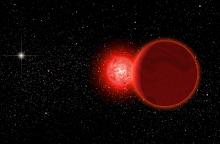Listen to today's episode of StarDate on the web the same day it airs in high-quality streaming audio without any extra ads or announcements. Choose a $8 one-month pass, or listen every day for a year for just $30.
You are here
Cursa
The profile of the star Cursa reads like this: It’s about twice as heavy as the Sun, two-and-a-half times as wide, and 50 times brighter. But every one of those numbers depends on one more: the star’s distance of 89 light-years.
Astronomers use a technique known as parallax to measure the distance to a nearby star. They compare its position to the background of stars when Earth is on opposite sides of the Sun. The star moves a little against that background between measurements. The amount it moves reveals its distance.
You can see how it works by holding a finger in front of your face. Look at it with one eye, then the other. Objects in the background shift position as you blink back and forth. And the closer the finger is to your face, the bigger the shift.
Cursa is quite close as stars go, so the shift is fairly large. Even so, the angle is tiny, so it takes really good measurements to work out the distance. The best view comes from spacecraft, above Earth’s blurring atmosphere.
The distance is critical for understanding a star. If Cursa was a little closer to us, then it would be smaller and fainter than calculated. And a greater distance would make it bigger and brighter — changing the star’s profile.
Cursa is easy to find right now. It represents the “footstool” of Orion, the hunter. During the evening hours it stands a little above Rigel, Orion’s brightest star, which is to the lower right of the hunter’s three-star belt.
Script by Damond Benningfield





